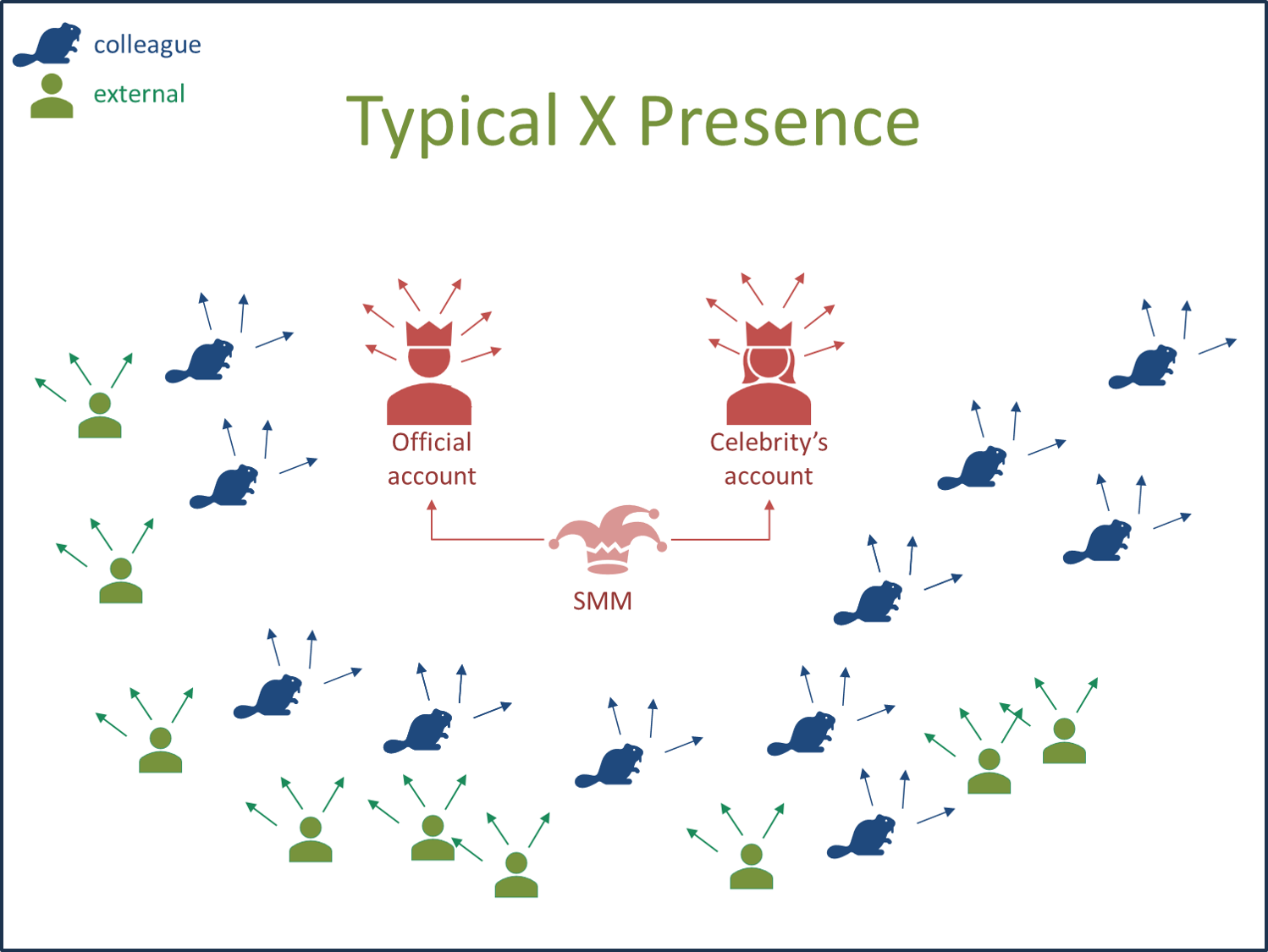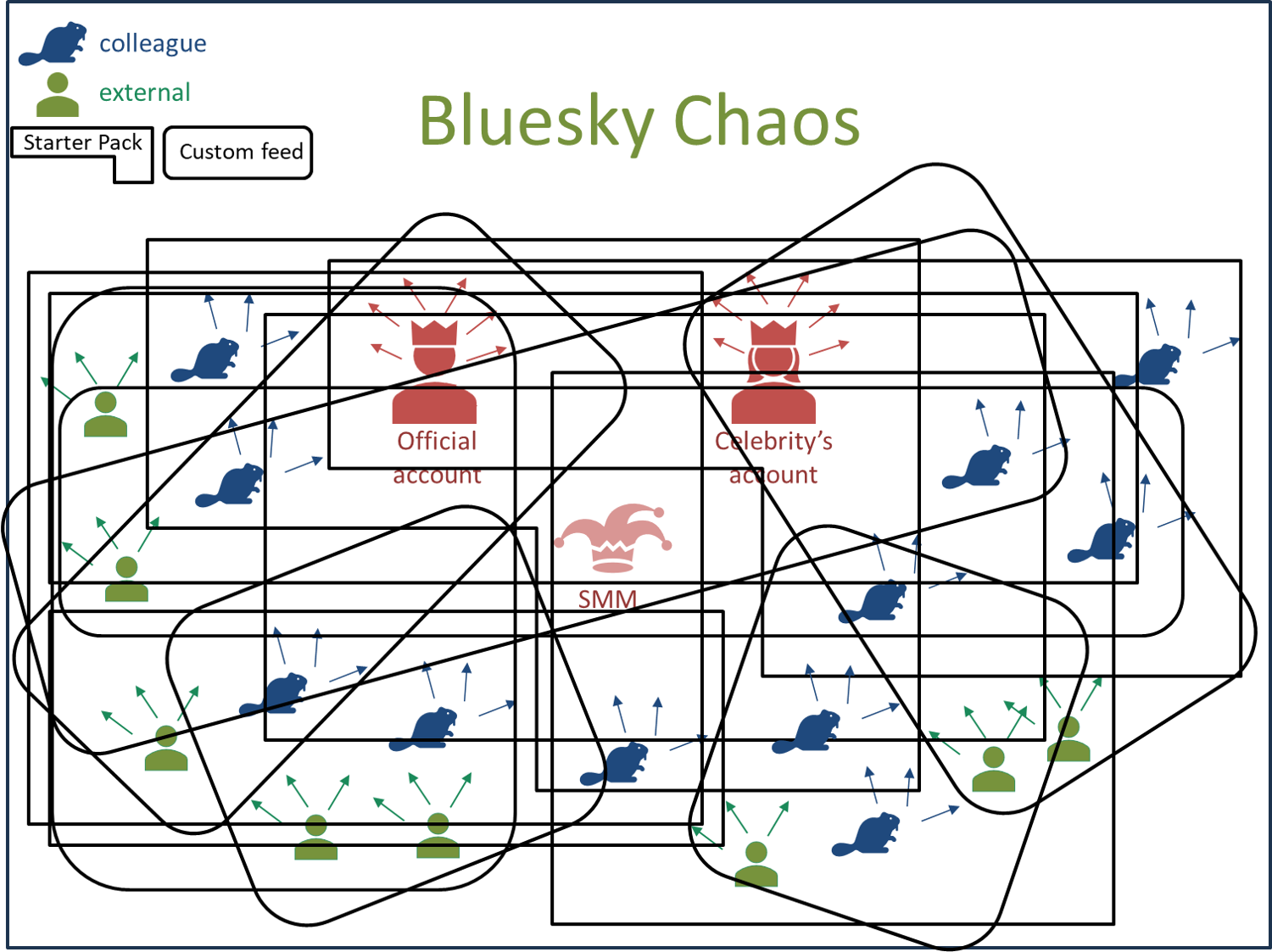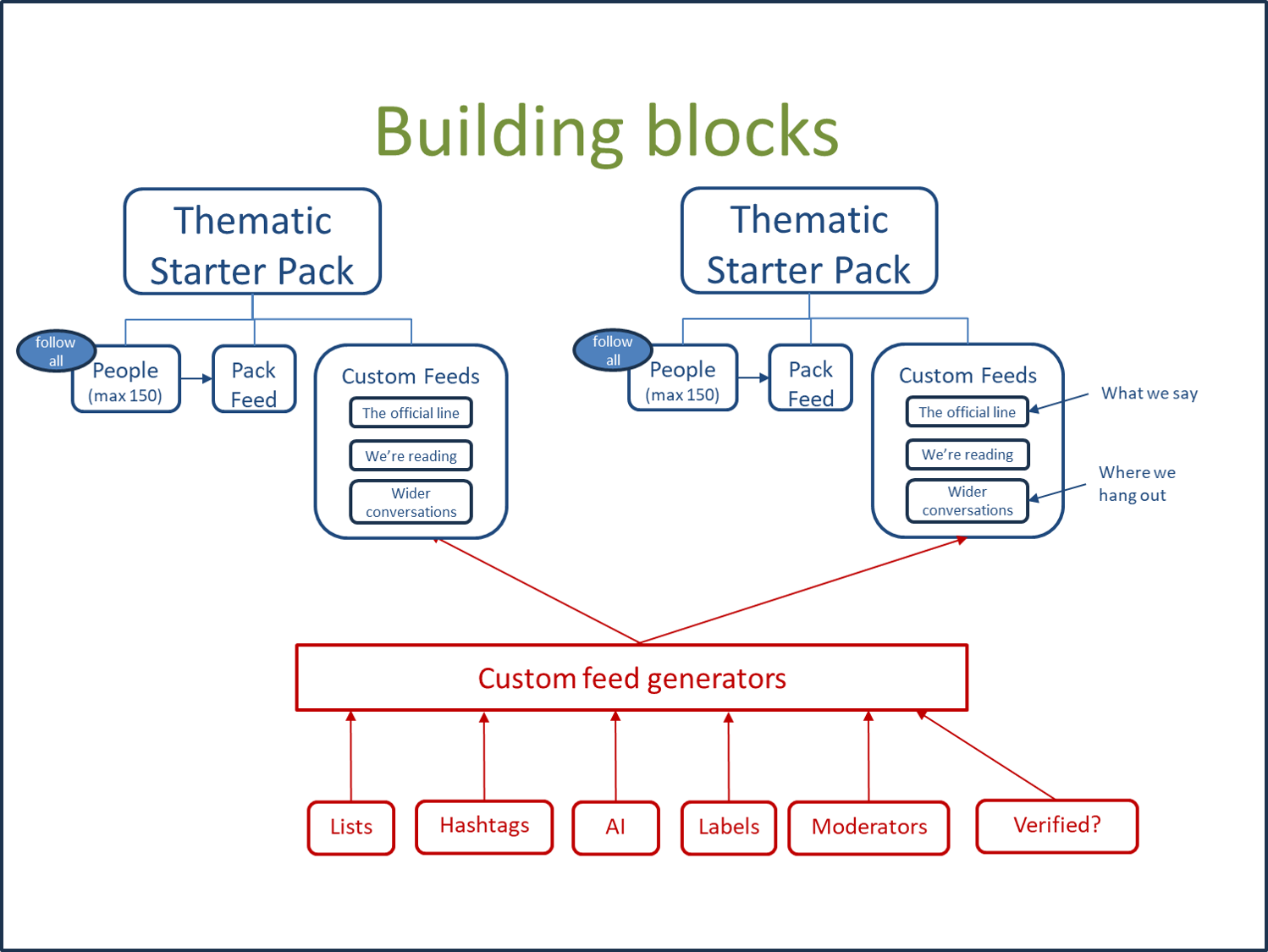Helping large organisations best use Bluesky
Let's build a tool to help large organisations coordinate their Bluesky footprint, helping them get the most out of the platform and thus stimulate Bluesky adoption.
(This is a followup to the workshop I held at the Ahoy conference in late April, 2025. This is version 3 (more version control info in the footer).)
One way to encourage the transition from X to Bluesky is to help large organisations efficiently organise and manage their Bluesky presence. The better they use Bluesky, the quicker they can accelerate their eXit Strategy.
I've been helping large organisations innovate online for 30 years: the emergence of the ATmosphere actually reminds me quite strongly of the mid-90s, when I tried to explain to the EU Institutions how important the Web would be.
Back then, communicators in these Institutions were focused on press and publications, so they looked at the Web through the paradigms of print and gatekeepers. Whereas today, when they look at Bluesky, they see it through a "Twitter but fewer people and Nazis" paradigm. They fail to see what sets it apart, and don't see the ATmosphere at all (despite my efforts).
But even if they could see Bluesky's unique features, the tools aren't available to help make the most of them. And that means making the plunge is probably not, in their view, the best use of their resources.
Challenges
Consider the plight of a social media manager (SMM) of any large organisation. An unknown number of their colleagues, spread across multiple departments, have X accounts, each interacting with their network "on a personal basis only".
The SMMs don't care: they control the "official" accounts of the institution itself and probably some of their celebrity bosses'. It is through these accounts, collectively known as the Crown Jewels, that they manage their organisation's official voice on X.
! Fig 1: Typical large organisation's X presence, a social media manager ghost-posts, broadcast-mode, from a few "Crown Jewels" accounts, and pays no attention to their colleagues' content or networks, or indeed to replies to the Crown Jewels accounts.
Fig 1: Typical large organisation's X presence, a social media manager ghost-posts, broadcast-mode, from a few "Crown Jewels" accounts, and pays no attention to their colleagues' content or networks, or indeed to replies to the Crown Jewels accounts.
In almost every case, that means treating X as a broadcast medium. Lots of people follow the Crown Jewels accounts because they're the organisation's official voice. So the SMM publishes the official news on X, but never replies, and never reTweet anything remotely interesting, because they're under a constant barrage of bad faith and trolls. So they broadcast, preferably without links.
Opportunities
When that strategy is your hammer, hitting the Bluesky nail with it makes little sense: after all, Bluesky has a fraction of X's population, and the organisation's network is a tiny fraction of that, so why bother with Bluesky?
I guess when you've been immersed in X since forever, it can be hard to see that X is not the only way microblogging can work. Perhaps therefore it's not surprising that few if any SMMs see that Bluesky offers something different. By combining Starters Pack, custom feeds, labellers, etc, organisations can create productive online communities based around microblogging on Bluesky and deeper interactions in their ATmosphere-enabled websites.
!
Fig 2: This SMM manages two Starter Packs, each including selected colleagues, some of whom are labelled as official spokespersons. Each Pack has a few custom feeds (2 shown), each sourcing content from selected colleagues and external, trusted accounts, according to a variety of algorithms and moderation processes. Other custom feeds exist outside of starter packs (not shown).
Building these communities, however, will require some coordination by SMMs, who will need to evolve into online community managers. Without coordination, each colleague on Bluesky will create My Own Personal Ultimate Starter Pack and several custom feeds, resulting in the same 300 accounts repackaged 6000 different ways.
! Fig 3: Each colleague promotes his/her own Starter Pack and custom feeds. It's fun, but the noise risks drowning out community.
Fig 3: Each colleague promotes his/her own Starter Pack and custom feeds. It's fun, but the noise risks drowning out community.
You can argue that the above chaos is good - it's creative, flexible, and even competitive (although less popular feeds stay in place, rather than being retired). But users could easily get lost in the noise, undermining the development of productive communities. Worse, the social media managers will feel out of control, and so could simply put a stop to everything.
Tool use cases
The building blocks of a good Bluesky presence for large organisations are to have, for each "thematic area", a Starter Pack highlighting the most relevant custom feeds (other custom feeds can exist outside of starter packs, of course - noone's being censored here).
! Fig 4: Starter Packs shouldn't just curate up to 150 accounts - they can also curate the most relevant custom feeds, which can be built and managed using a variety of tools in a variety of ways.
Fig 4: Starter Packs shouldn't just curate up to 150 accounts - they can also curate the most relevant custom feeds, which can be built and managed using a variety of tools in a variety of ways.
These feeds, in turn, are built using a variety of 3rd party feed generators, which in turn use a combination of tags, lists, labels and algorithms (and probably verifications), and may be moderated (pre- and/or post-publication).
In short, there are quite a few tools and factors to be kept track of. Moreover, different people throughout the organisation will probably manage different feeds, packs, lists, labels, etc. And finally, such a system also requires workflows where people are added and removed from packs, lists, feeds, labellers etc., usually at the suggestion or command of other people.
How's a SMM to cope?
! fig 5. Outlining the key elements of the required tool
fig 5. Outlining the key elements of the required tool
They will need tools to support a variety of tasks:
- track all official starter packs, lists, custom feeds and labellers:
- which person and which feed is in which pack?
- who manages pack, and who manages each feed?
- how is each feed built: what lists, tags, labels etc are used? And who manages those? Is there pre- or post-publication moderation, and who does that? etc.
- allow authenticated users to request/suggest/upvote account inclusion and exclusion for each starter pack, list, custom feed and labeller, with requests forwarded to the appropriate managers according to organisationally-defined workflows
- (what "authenticated" means will depend on the organisation.)
- help manage the community conversations: this is actually where things get interesting (and is tied closely to the next point), so this is something I'd love to explore in greater depth in another post
- provide organisation-grade analytics
- and much more...?
What's next
If you're reading this then you almost certainly know the discord server (if you don't, ping me on Bluesky or drop me a line), so I suggest we meet there to discuss and move forward on the following goals, suggested before and at Ahoy!
- scope out the features: the above is designed to kickstart this discussion, but I'm very open to other user requirements - let's try and capture every use case first, and prioritise later
- estimate how much work this would be to build
- agree a plan for creating it: should this be an online business, an OS github repository, both, or something else? Do we need funding, and if so from where?
- assemble a team, create a space to work in, and get to it.
More reading
- I see this project as a very small part of meeting the much larger Bluesky Adoption Challenge
- There's a Bluesky/ATmosphere overview on my Hub, where you'll also find everything about Ahoy.
Revision Notes
This is one of this wiki's pages managed with the permanent versions pattern described in Two wiki authors and a blogger walk into a bar…
- changes in this version:
- v2 idea was accepted and the workshop held (see newsletter)
- developed text and added slides
- version control
- this is version: 3
- this is the current version: how could a large organisation best use bluesky
- here is the previous version: how could a large organisation best use bluesky 2